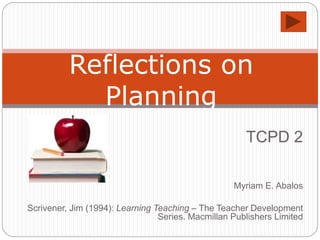
Abalos.pps
- 1. TCPD 2 Myriam E. Abalos Scrivener, Jim (1994): Learning Teaching – The Teacher Development Series. Macmillan Publishers Limited Reflections on Planning
- 2. How to be a reflective practitioner?
- 3. Not like this for sure!!! Goofy – Teachers Are People Watch the following video and analize what teachers need to pay attention to when planning their lessons.
- 4. We need to think about many aspects that have to do with planning
- 5. There are some general areas to consider when planning: Learners Aims Teaching Point Teaching Procedures Material Classroom Management
- 6. The Learners Will they enjoy during the lesson? Will they benefit from it? What do they like doing? What topics interest them?
- 7. The aims What will the learners achieve? What are you hoping to achieve yourself as a teacher? What are the aims of the lesson? What are the aims of each activity?
- 8. The teaching point What is the subject matter of the lesson? What items of language or skills will be studied or used in the lesson? What topics, contexts will be dealt with? Am I confident about these teaching points? What preparation / study do I need to do?
- 9. The teaching procedures What activities will you use? What sequence will they come in? What activities will help the learners achieve the lesson objectives? How will the activities link together to make a whole lesson? How long will each activity last?
- 10. Materials What texts, tapes, pictures, exercises, role cards, web sites, etc will you use? What do I need to make, photocopy, borrow? What page of the coursebook have we got to? What can be used for homework?
- 11. Classroom management What will you say? What instructions will I give? What happens if students don’t understand my instructions? How will the seating be arranged? How much time will each stage take? How long is the whole lesson?
- 12. To which of the sections of the diagram would you assign the following? How many separate activities will there be? Where will I stand or sit? What do learners need? What skills will learners be working on? How will I control timing? What are some of the aspects that could cause difficulties or go wrong? How am I going to deal with mistakes? Is there going to be variety of activity in the lesson? How do the lesson objectives fit in with longer term goals? What do they know already?
- 13. Teaching implies… Options Decisions Actions
- 14. Imagine a lesson in terms of a cross-country hike – you know where you want to end up, even though you perhaps can’t see the end from the starting point. Getting to that end point is your main aim or objective. You may have various decisions to make about the way that you get to that goal: the route you take, what map you use, where you will rest, what aids you take to help you, etc. All these decisions are related to the main decision about the objective – if this is not clear, the walk could still be enjoyable, but you will probably pass by fewer interesting sites, meet a number of unexpected problems, and more likely to get completely lost.
- 15. What is teaching a foreign language then and what does it imply? It implies making decisions on what way to take in order to get to a certain objective.
- 16. An interesting lecture by Keith Johnson Watch VIDEO Is this what you think about teaching a foreign language?
- 17. The teacher’s most important job should be to create the conditions for which learning can take place. If this is true then, a teacher’s job implies having options, making decisions and taking actions.